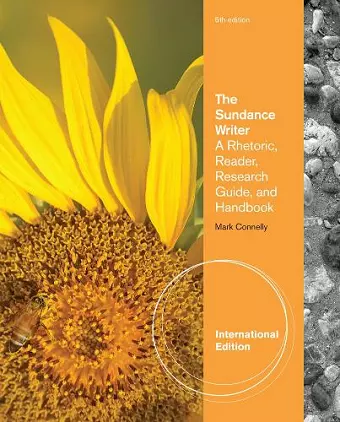The Sundance Writer
A Rhetoric, Reader, Research Guide, and Handbook, International Edition
Format:Paperback
Publisher:Cengage Learning, Inc
Published:1st Jan '12
Currently unavailable, our supplier has not provided us a restock date

Praised for its practical strategies, real-world emphasis and focus on critical thinking, this successful 4-in-1 text (rhetoric, reading, research guide, and handbook) prepares students for writing in college and in the workplace. This edition has been revised so that students move more quickly from the writing process to writing in the modes and incorporating research into their writing projects.
1. Why Write? Part I: THE RHETORIC. 2. The Writing Process: An Overview. 3. The Writing Context. 4. Critical Thinking: Seeing With a Writer's Eye. 5. Prewriting Strategies: Getting Started. 6. Developing a Thesis. 7. Supporting a Thesis. 8. Organizing Ideas. 9. Developing Paragraphs. 10. Writing the First Draft. 11. Revising and Rewriting. 12. Editing and Proofreading. Part II: THE READER. NEW Readings * 13. Becoming a Critical Reader: Reading with a "Writer's Eye." 14. Description: Presenting Impressions. LANSING LAMONT, The Bomb (description of object) (annotated).* TRUMAN CAPOTE, Out There (description of a place). JOSE ANTONIO BURCIAGA, My Ecumenical Father (description of a person). LUIS ALBERTO URREA, Border Story (description of place and people). CRITICAL ISSUES: IMMIGRATION. BLENDING THE MODES. PAUL M. BARRETT, American Islam (description of people, idea, issue). WRITING BEYOND THE CLASSROOM. BAYOU PRINTING WANT AD. 15. Narration: Relating Events. SAMUEL SCUDDER, Take This Fish and Look at It (first person) (annotated). RAMON "TIANGUIS" PEREZ, (first person) The Fender-Bender. MARTIN GANSBERG, Thirty-Eight Who Saw Murder and Didn't Call the Police (Third person objective narration).* JAMES DILLARD, A Doctor's Dilemma (first person). CRITICAL ISSUES: HEALTHCARE. BLENDING THE MODES. GEORGE ORWELL, Shooting an Elephant. WRITING BEYOND THE CLASSROOM. HOTEL INCIDENT REPORT.* 16. Example: Presenting Illustrations. ANNA QUINDLEN, Homeless (annotated). JOE RODRIGUEZ, Mexicans Deserve More Than La Mordida. SHARON BEGLEY, What's in a Word? (multiple examples).* BLENDING THE MODES. CAROLYN M. BROWN, Attacking Student Loan Debt.* CRITICAL ISSUES: DEBTOR NATION.* WRITING BEYOND THE CLASSROOM. COVENANT HOUSE NEEDS YOUR HELP. 17. Definition: Establishing Meaning. EILEEN SIMPSON, Dyslexia (standard definition) (annotated). ELLEN GOODMAN, The Company Man (extended definition). ALISSA QUART, Listening to Madness (invented definition).* BLENDING THE MODES. JO ELLEN GREEN KAISER, What is an Act of Terror?* CRITICAL ISSUES: THE WAR ON TERRORISM. WRITING BEYOND THE CLASSROOM. DON ROSENBERG What is Depression? 18. Comparison and Contrast: Indicating Similarities and Differences. YI-FU TUAN, Chinese Space, American Space (annotated). BRUCE CATTON, Grant and Lee (comparison of two people). RACHEL CARSON, A Fable for Tomorrow (before and after comparison). CRITICAL ISSUES: THE ENVIRONMENT.* BLENDING THE MODES. CHRISTOPHER JENCKS, Reinventing the American Dream (comparison of ideas).* WRITING BEYOND THE CLASSROOM. Peggy Kenna and Sondra Lacy, Communications Styles: United States and Taiwan. 19. Process: Explaining How Things Work and Giving Directions. MORTIMER ADLER, How to Mark a Book (directions) (annotated). ARMOND D. BUDISH, Fender Benders: Do's and Don't's (directions). MARVIN HARRIS, How Our Skins Got Their Color (explanation of process). DAVIDYNE MAYLEAS, How to Land the Job You Want (directions). CRITICAL ISSUES: THE JOB MARKET. BLENDING THE MODES. MALCOLM X, My First Conk. WRITING BEYOND THE CLASSROOM. STEIN AND GIOTTA ASSOCIATES, Conducting a Self Assessment.* 20. Division and Classification: Separating into Parts and Rating Categories. JUDITH VIORST, Friends, Good Friends--and Such Good Friends (division)(annotated). JAMES AUSTIN, Four Kinds of Chance (classification). MARTIN LUTHER KING JR., Ways of Meeting Oppression. BLENDING THE MODES. EDWARD KOCH, Death and Justice: How Capital Punishment Affirms Life. CRITICAL ISSUES: CRIMINAL JUSTICE. WRITING BEYOND THE CLASSROOM. MOTION PICTURE ASSOCIATION OF AMERICA, Parents Stay Ahead of the Curve! 21. Cause and Effect: Determining Reasons and Measuring Results. JOHN BROOKS, The Effects of the Telephone (effects) (annotated). JOHN TAYLOR GATTO, Why Schools Don't Educate (causes). LOUIS MIZELL JR., Who's Listening to Your Cell Phone Calls?* CRITICAL ISSUES: PRIVACY IN THE ELECTRONIC AGE.* OPPOSING VIEWPOINTS: LEGALIZING DRUGS. PETER MOSKOS, Too Dangerous Not to Regulate.* LEE P. BROWN, End the Demand, End the Supply.* WRITING BEYOND THE CLASSROOM. CAMPUS HEALTH CENTER, Causes and Effects of Sharing Prescription Drugs.* 22. Argument and Persuasion: Influencing Readers. BLENDING THE MODES. MARY SHERRY, In Praise of the "F" Word. CRITICAL ISSUES: PUBLIC SCHOOLS. OPPOSING VIEWPOINTS: ETHNIC IDENTITY. ARMSTRONG WILLIAMS, Hyphenated Americans. JULIANNE MALVEAUX, Still Hyphenated Americans. OPPOSING VIEWPOINTS: BANKRUPTCY.* JANE BRYANT QUINN, The Case for Walking Away.* TAMARA E. HOLMES, Filing for Bankruptcy is Not a Smart Financial Move.* OPPOSING VIEWPOINTS: NUCLEAR POWER.* PATRICK MOORE, Nuclear Power is a Clean Energy Source.* SHERWOOD ROSS, Nuclear Energy Pollutes.* WRITING BEYOND THE CLASSROOM. AMERICA'S SECOND HARVEST Hunger in the United States. Part II: THE RESEARCH PAPER. 23. Conducting Research. 24. Writing the Research Paper. Part IV: WRITING IN COLLEGE. 25. The Essay Examination. 26. Writing About Literature. Part V: WRITING IN THE INFORMATION AGE. 27. Analyzing Visuals: Seeing With a "Writer's Eye." 28. Writing with Visuals. 29. Business and Professional Writing. 30. Special Writing Contexts. Part VI: GRAMMAR AND HANDBOOK. 31. Grammar. 32. The Handbook.
ISBN: 9781111840235
Dimensions: 232mm x 187mm x 28mm
Weight: 1150g
816 pages
5th edition